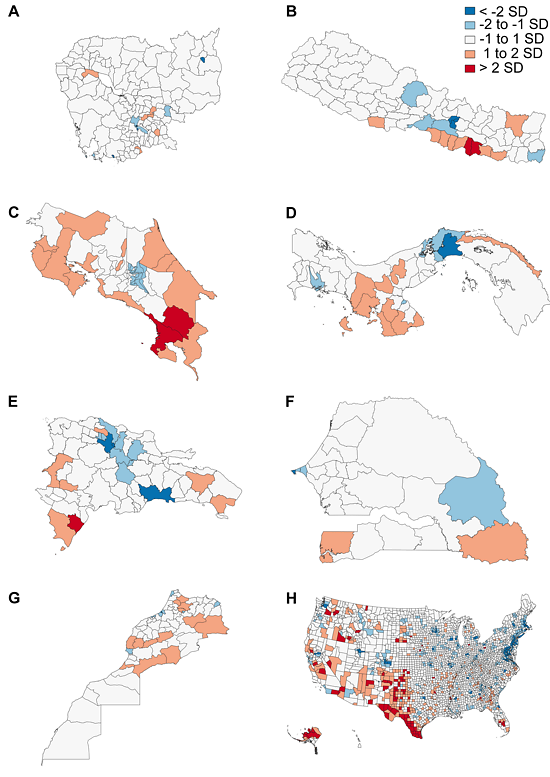Arbeitsbereich
Bevölkerungsdynamik und Nachhaltiges Wohlbefinden
Auf einen Blick
Projekte
Publikationen
Team
Projekt
Methodological Improvements to the Study of Social Vulnerability
Carolina Coimbra Vieira, Rumi Chunara (New York University, Vereinigte Staaten), Ronak Paul (International Institute for Population Sciences, Mumbai, Indien), Sean Reid (University of California, Santa Barbara, Vereinigte Staaten), Christopher Wolfe (University of Nevada, Reno, Vereinigte Staaten), Yan Zhang (University of Oxford, Vereinigtes Königreich von Großbritannien und Nordirland), Yuan Zhao (New York University, Vereinigte Staaten)
Ausführliche Beschreibung
Social conditions shape an individual’s response to external environmental hazards. This includes the degree to which an individual or a community responds to natural disasters, economic changes, or global health crises. Social vulnerability is a multidimensional measure of the social conditions that define how such actors respond to hazards. A range of studies demonstrated the numerous ways in which social vulnerability significantly determined community outcomes, such as with floods (Hamidi, et al. 2022), earthquakes (Zhang, et al. 2017), and noncommunicable diseases (Khan, et al. 2021).
The factors that lead to social vulnerability are theoretically well-defined and include, for example, economic status, age, disability, language, ethnicity, and location. Theoretical knowledge has enabled the creation and validation of social vulnerability indices across many specific locations and outcomes. However, existing approaches generally assume structured, linear relationships among input variables, and they may not capture subtle nonlinear patterns that represent the multidimensionality of social vulnerability more precisely. Other methodological challenges include the fact that the data resources available and used are often fairly limited. In addition, the variables included often are selected by hand (through expert opinion, but not always so) to represent specific concepts, as opposed to using a data-driven method. These data and method limitations affect the quality and comparability of a number of social vulnerability measures.
In our first study, we produced a standard and comparable social vulnerability index across eight countries. We used global harmonized data from the Integrated Public Use Microdata Series (IPUMS) project as well as novel methodologies in deep learning techniques, such as autoencoders, to delineate patterns of social vulnerability in Cambodia, Nepal, Costa Rica, Panama, the Dominican Republic, Senegal, Morocco, and the USA. Initial results have shown that wealth-related factors explain the largest variance in the data and that these factors are the most common elements of social vulnerability. A data-driven approach to variable selection was used for the internal and external validation of the indices that we developed. Variable selection also included the relationship between the constructed index and childhood mortality. Given the growing nature of hazards that affect multiple environmental, social, and economic aspects of society, the consistent relevance of wealth reveals an important dimension of resilience to natural and anthropogenic risks.
This research line has a range of implications for both research and policy. Given the increasing relevance of social vulnerability associated to natural, anthropogenic, and socionatural hazards, our findings inform data collection and the development of indices for other places and can address various needs of policy-makers. Although IPUMS provides an important harmonized data resource, the basic data needed to compose the social vulnerability index was only available in seven countries. Accordingly, understanding the components that capture the most variance in social vulnerability helps in prioritizing data collection in new places and in estimating social vulnerability in places where data covering all base concepts are not available.
Social Vulnerability Index scores across administrative units in eight countries - Cambodia, Nepal, Costa Rica, Panama, Dominican Republic, Senegal, Morocco, and USA

Maps of Social Vulnerability Index (SoVI) scores on each administrative unit. Each administrative unit is visualized by vulnerability using a standard deviation representation similar to Cutter et al. (2003). Places with SoVI values between -1 and 1 standard deviations from the mean are shown in gray and indicate neutral vulnerability. Scores greater than 1 standard deviation above the mean are shown in orange and red indicating higher vulnerability. Scores less than -1 standard deviation below the mean are shown in light and dark blue indicating lower vulnerability. All SoVI scores were computed using the same harmonized IPUMS variables, except for the United States, and the scale is standardized across all countries. Countries are displayed in the following order: A. Cambodia, B. Nepal, C. Costa Rica, D. Panama, E. Dominican Republic, F. Senegal, G. Morocco, and H. USA © Paul, R., et al. (2023). Methodological Improvements in Social Vulnerability Index Construction Reinforce Role of Wealth Across International Contexts.
Daten und Erhebungen, politische Maßnahmen, Politik, Verwaltung, Wohlfahrtsstaat
Costa Rica, Dominikanische Republik, Kambodscha, Marokko, Nepal, Panama, Senegal, Vereinigte Staaten, Welt
Publikationen
Zhao, Y.; Paul, R.; Reid, S.; Coimbra Vieira, C.; Wolfe, C.; Zhang, Y.; Chunara, R.:
Social Indicators Research. (2024)

Paul, R.; Reid, S.; Coimbra Vieira, C.; Wolfe, C.; Zhao, Y.; Zhang, Y.; Chunara, R.:
MPIDR Working Paper WP-2023-017. (2023)
